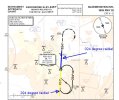bqmassey
Line Up and Wait
Hello
I was reading through some ground school lessons online, and a question popped up that I haven't found an answer for. I'd appreciate if someone explain this to me a little bit.
I'm wondering if a VOR has 180 or 360 radials. If I'm flying with the needle centered while magnetic south of the station and flying magnetic north with the flag on "To", am I on the 180 radial or the 180-360 radial?
I think that there are 180 paired radials, but I'm not sure. If this is the case, though, couldn't there be some confusing as to which side of the VOR you're on? With needle centered, OBS on 180, and the flag saying "From", couldn't you either be north of the station flying north or south of the station flying south?
If you are flying on the needle, with the OBS matching your compass heading, and flag saying "To", and you pass over the VOR, what happens? Does the flag just flip? Does the needle fly to a side, since the radial is now on the opposite side of the VOR?
These are just some questions I have. I'd appreciate help with them, but I'll keep trying to find some answers.
Thanks!
Brandon
I was reading through some ground school lessons online, and a question popped up that I haven't found an answer for. I'd appreciate if someone explain this to me a little bit.
I'm wondering if a VOR has 180 or 360 radials. If I'm flying with the needle centered while magnetic south of the station and flying magnetic north with the flag on "To", am I on the 180 radial or the 180-360 radial?
I think that there are 180 paired radials, but I'm not sure. If this is the case, though, couldn't there be some confusing as to which side of the VOR you're on? With needle centered, OBS on 180, and the flag saying "From", couldn't you either be north of the station flying north or south of the station flying south?
If you are flying on the needle, with the OBS matching your compass heading, and flag saying "To", and you pass over the VOR, what happens? Does the flag just flip? Does the needle fly to a side, since the radial is now on the opposite side of the VOR?
These are just some questions I have. I'd appreciate help with them, but I'll keep trying to find some answers.
Thanks!
Brandon



